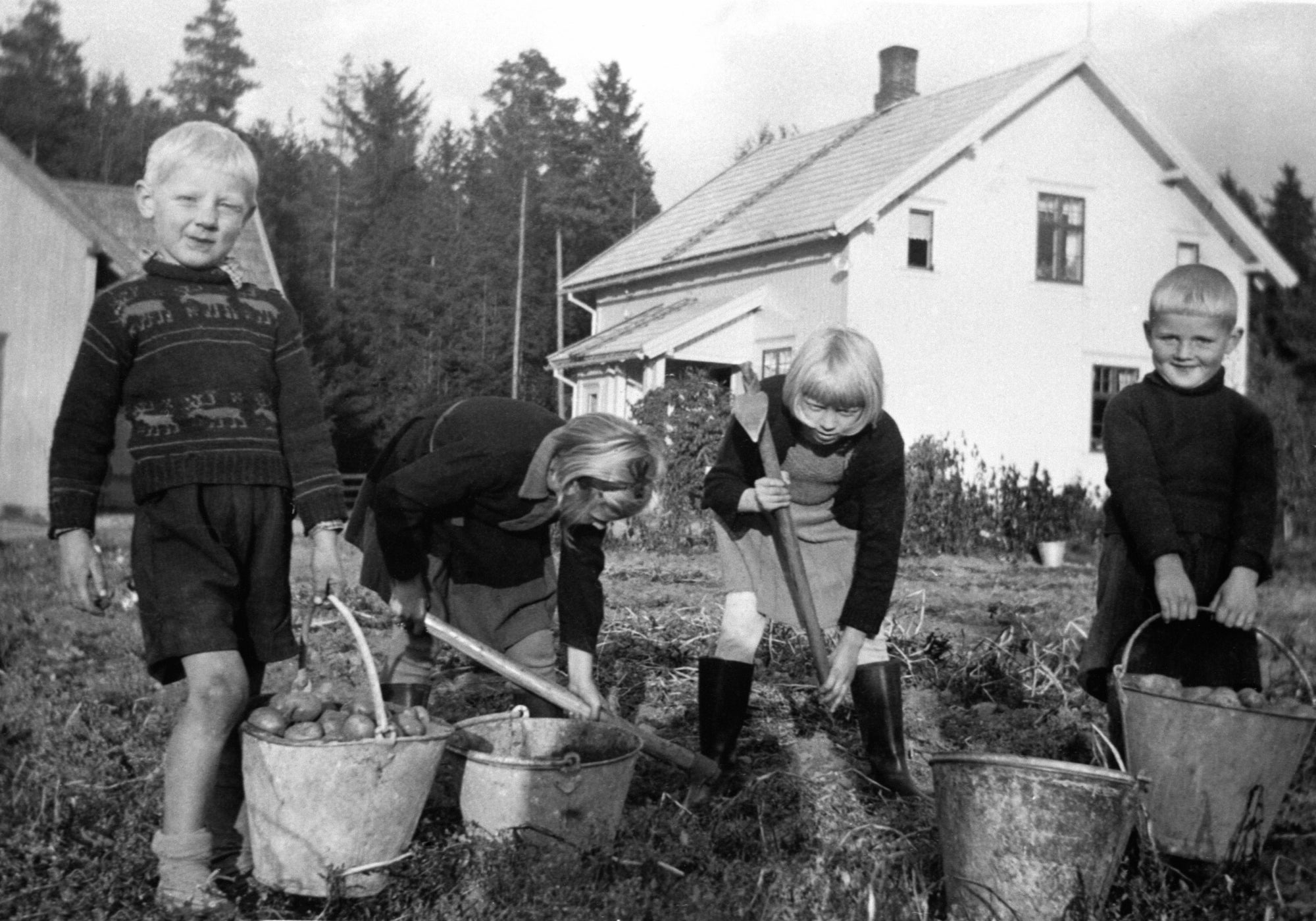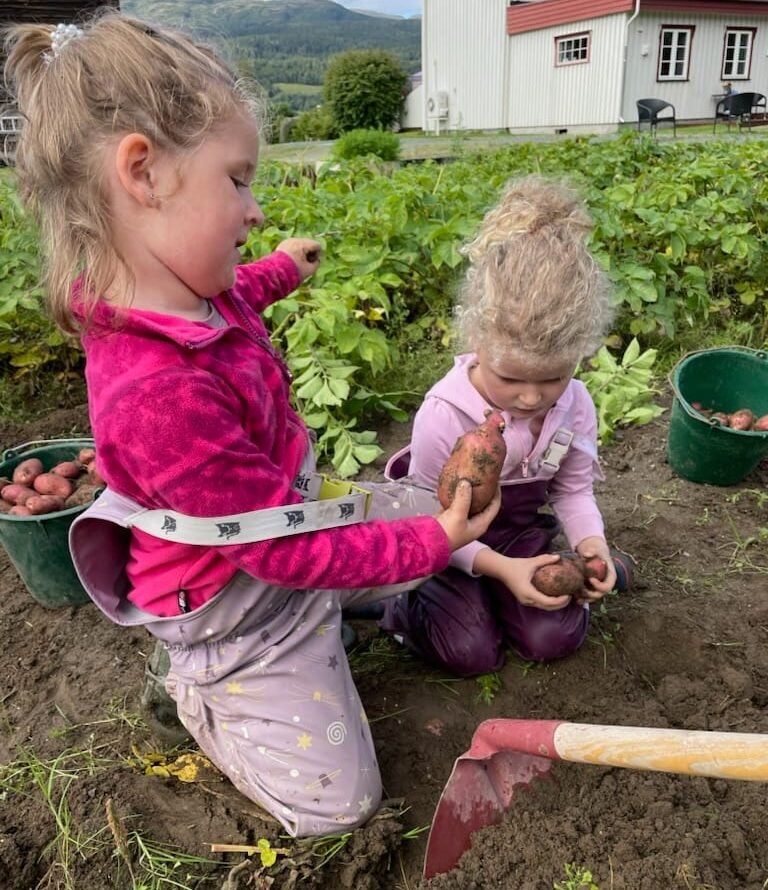
In Norway, my family lived by the rhythm of the potato harvest. I still remember everything it taught me.
As a kid, it was my job to get the potatoes going after school. My parents would arrive home not long after me and make the rest of the meal, but the foundation was almost always potatoes, which took the longest to cook. In the morning, my mother would place the unpeeled potatoes—usually pink-skinned Pimpernels, tough and mealy—in salty water, covering the aluminum pot with a lid. All I had to do was turn the stove dial to medium.
Once finished, the potato pot was placed on the table next to an empty dish for their skins. I’d reach in and skewer a spud with my fork, holding it in place as I peeled it with my dinner knife. Then I’d add the rest of the dinner to the potatoes on my plate—maybe fish cakes in creamy white sauce, or elk meat cakes in rich brown sauce—and start to eat.
My family comes from potato country, specifically from Nordstuggu Re, one of the six Re farms in the Trøndelag region of Norway. Ree is our name, too—it’s my middle name—spelled a little differently for reasons lost to history but forever tying us to this place and its ways of doing things.
I grew up in the next village over from my grandparents’ farm, which is where our potatoes came from. My grandparents lived according to a rhythm set by nature, always needing to be home in time for the cattle feeding. Occasionally they’d go somewhere to visit family, but mostly I could rely on them being at home, in the white house with the currants in the garden, or in the red barn next to fields of barley, grass, and potatoes. The farmhouse had an entire cellar full of preserved foods—jars of pickled beets, cabbages hanging on nails, frozen meats, endless jam. Most important, there was a cool, dark potato cellar where mountains of spuds from the previous fall rested on cement floors.
If you look after your potatoes, they will feed you for a whole year. But there’s a lot of care that goes into making sure that happens. Grandpa Per Ree paid constant attention to every step, starting with the planting: delicate Sharpe’s Express potatoes were his favorite, but they didn’t keep for long, so he also planted pink-skinned Pimpernels, hardier in the field and ideal for lasting through the winter. The field required attention over the summer, and the harvest was a major operation, but the most painstaking job of all took place in the potato cellar in the winter and spring, when Grandpa made sure nothing froze and nothing sprouted, which happens if too much light leaks in. Sprouted potatoes turn wrinkly, and eating an overly sprouted potato can even make you sick. When the potatoes inevitably started to sprout, Grandpa would examine each and every one of them, picking them clean. Thanks to his vigilance, there were always enough potatoes to last until the next harvest.
Grandpa has been gone nearly seven years now, and I’m still not used to it. There’s something impossible to understand about the loss of someone who’s been with you forever. How ridiculous is it, that you’re just supposed to accept that there’s now one less face among the ones you’ve always known?
Boiled potatoes were the mainstay at my grandparents’ farm, served with almost every dinner. Grandma Oddlaug Ree also turned the bounty into potato cakes, “potetlemse” (similar to what Norwegian Americans call “lefse”), and crispy flatbread made with potato flour. There was always enough food at the farm—and it was good food, too—but it wasn’t limitless. “My mother was a good cook, but it was a lot of work to feed seven people every day,” says my mother, Magni Ree. “We usually had soup or dessert in order to stretch the main course, and our nana was always urging us to ‘eat bread,’” she says, referring to flatbread.
When I grew up, there was always a stack of flatbread served with dinner. My mother didn’t tell me to fill up on it, but some of the food mentality from her childhood carried through: she would scold me for “mauling,” which in Norwegian refers to eating something precious like cheese or sausage on its own rather than as part of a meal. I instinctively understood it to be greedy and wasteful.
The Nordstuggu Re potato field measured about 5,000 square meters, just smaller than a soccer field. The potatoes were planted in May, after the last frost, using seed potatoes that Grandpa had saved from last year.
“When the potato plants start to grow, you do what’s called ‘hypping,’” says my mother, using a term I’ve never heard before. It means covering the bottom of the plant with soil to prevent growing potatoes from being exposed to air, which would turn them green and inedible. In English this is called “earthing up”—my English is nearly native at this point, but every now and again I come across a specialist field where I’m lacking vocabulary. I’ve lived my whole adult life in England, but there are things I’ve only ever done in Norway. Sounds and smells can pull you back in time, and so can a language from the past. I’m used to having two words for everything, but when that fails, it’s like only one of my two worlds exists. I love potatoes, but I hardly ever make them in England—for me, potatoes are Norway.
In the summer, the potato plants will bloom, filling the field with white or purple flowers. The big harvest comes in September, during what previous generations called the Potato Break, when all the children would leave their classrooms to go around the village picking potatoes. Even after the potato plant has been crushed (using a contraption resembling an upside-down bathtub) and the soil has been upturned by the tractor, this is hard work—but it was even harder back in the day, when they’d have to dig out the spuds by hand. The potatoes were collected in mesh buckets, which allowed the dirt to fall away, and deposited in wooden boxes that were transported back to the farm by tractor. There they’d be tipped into the potato cellar through an open window, by way of a ramp designed for the purpose.
On harvest day, Grandma was in charge of catering. “The workers got breakfast before starting, and then there were mid-morning potato cakes with syrup or cheese served in the field, to tide them over. At midday it was usually stew, and then in the afternoon, coffee and sheet cake,” she says, remembering it exactly. No one left until the field was empty. Norwegian schools don’t have the Potato Break anymore, as it’s evolved into Fall Break—even though they got paid, Grandma doesn’t think today’s kids would put up with it.
The Nordstuggu Re potato heyday is in the past, but in recent years, there’s been a small revival. My uncle Arnt Ree and his family, who run the farm now, have a few rows of potatoes again. They’re using the same old equipment since it works just fine—this is about keeping the flame alight on a proud tradition of self-sufficiency, and also bringing a new generation of Ree kids into the potato field.
“If you remember everything I’ve said today, then you know a lot,” Grandma says as I’m leaving her house after our afternoon reminiscing about the farm, but she doesn’t need to worry. I remember the potato mountain in the cellar, the red currant cordial in clear bottles, Grandpa napping on the divan sofa, Grandma in her Crimplene dress and curlers. I remember when Grandpa took me to see the cranes in the field, letting me drive the tractor even though I didn’t know how—it was so loud, but the birds would fly away if you approached on foot. I remember Grandma teaching me embroidery, splitting the delicate thread in half to make it go further. Even today, I would never eat a piece of sausage all on its own, always reaching for a boiled potato to stretch it.
